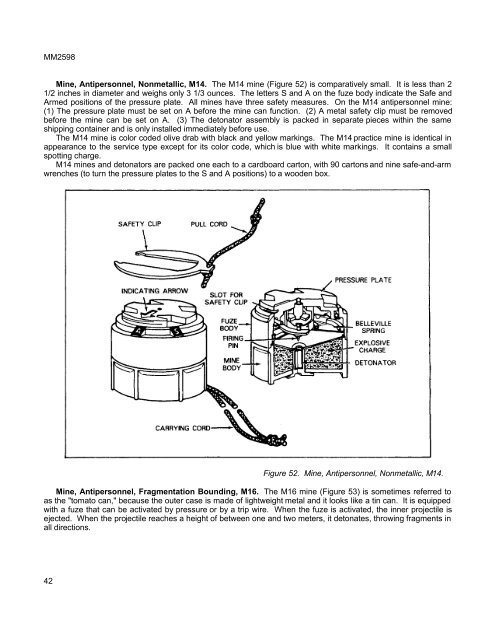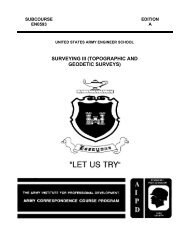<strong>MM2598</strong>or thermite (TH3), and is used to produce intense heat – up to 4,000F – to destroy equipment. The incendiarygrenade is color coded light-red with black markings.Riot-Control Grenades. Riot-control grenades (Figure 51e) are used to control prisoners and crowds, toneutralize bunkers and tunnels, and to simulate casualty agents during training. A riot-control grenade has thesame beverage-can appearance as smoke and incendiary grenades, but it is filled with tear gas mixture. As themixture burns, tear gas is emitted from the emission holes. Riot-control grenades are color coded gray with darkredmarkings and a dark-red band.Illuminating Hand GrenadesIlluminating hand grenades are used for illumination and signaling. Because of the high temperaturegenerated by the burning illuminant, they may also be used for incendiary purposes against combustible targets.At first glance, the illuminating hand grenade seems to look just like the fragmentation hand grenade. A closerinspection, however, reveals obvious differences in shape and a body made of two pieces joined together. Thisgrenade is found in two color codes, all white with black markings or unpainted with a white band and whitemarkings.Practice Hand GrenadesExcept for their color code, oval practice hand grenades look identical to fragmentation grenades. They have ahollow steel body, a fuze, a small spotting charge, and a plastic stopper in the bottom. When the fuze functions,the spotting charge is ignited, the stopper is blown out, and a puff of smoke marks the impact point. The roundpractice hand grenade functions similarly, but it has no stopper and the spotting charge is in the fuze. This typemakes a loud noise as well as a puff of smoke. Practice hand grenades are color coded blue with a brown bandand white markings.IDENTIFYING LAND MINESA land mine is a device filled with a high-explosive or a chemical that is placed above or below the ground to bedetonated when a target touches or moves near it. Land mines are classified according to purpose as service orpractice. They are classified by filler as high-explosive, chemical, or inert. The most commonly known method ofclassification, however, is by use-antipersonnel (apers) and antitank (at).Antipersonnel (apers) MinesThere are two basic types of antipersonnel mines, the blast type, which explodes without fragmentation, andthe fragmentation type, which explodes with fragmentation. Fragmentation mines are further divided into boundingand fixed-directional types.The bounding fragmentation type is placed beneath the surface of the ground. When it functions, afragmentation projectile is expelled to a height of one to two meters, where it detonates, fragmenting in alldirections. The fixed-directional fragmentation type is placed on the ground or attached to a stationary object sucha tree or pole. It faces the expected path of the enemy. When it functions, the fragments fan outward horizontallyabove the ground.Four of the antipersonnel mines now in US Army stocks include: mine, antipersonnel, nonmetallic, M14; mine,antipersonnel, fragmentation bounding, M16; mine, antipersonnel, fragmentation bounding, M26; and mine,antipersonnel, M18A1.41
<strong>MM2598</strong>Mine, Antipersonnel, Nonmetallic, M14. The M14 mine (Figure 52) is comparatively small. It is less than 21/2 inches in diameter and weighs only 3 1/3 ounces. The letters S and A on the fuze body indicate the Safe andArmed positions of the pressure plate. All mines have three safety measures. On the M14 antipersonnel mine:(1) The pressure plate must be set on A before the mine can function. (2) A metal safety clip must be removedbefore the mine can be set on A. (3) The detonator assembly is packed in separate pieces within the sameshipping container and is only installed immediately before use.The M14 mine is color coded olive drab with black and yellow markings. The M14 practice mine is identical inappearance to the service type except for its color code, which is blue with white markings. It contains a smallspotting charge.M14 mines and detonators are packed one each to a cardboard carton, with 90 cartons and nine safe-and-armwrenches (to turn the pressure plates to the S and A positions) to a wooden box.Figure 52. Mine, Antipersonnel, Nonmetallic, M14.Mine, Antipersonnel, Fragmentation Bounding, M16. The M16 mine (Figure 53) is sometimes referred toas the "tomato can," because the outer case is made of lightweight metal and it looks like a tin can. It is equippedwith a fuze that can be activated by pressure or by a trip wire. When the fuze is activated, the inner projectile isejected. When the projectile reaches a height of between one and two meters, it detonates, throwing fragments inall directions.42
- Page 1: IDENTIFYING AMMUNITIONSubcourse MM
- Page 6 and 7: MM2598shotgun shell, for example, m
- Page 8 and 9: MM2598Tracer. The tracer round is u
- Page 10 and 11: MM2598Figure 7. Practice Cartridge.
- Page 12 and 13: MM2598Dummy Ammunition. Dummy ammun
- Page 14 and 15: MM2598loaded into the weapon separa
- Page 16 and 17: MM2598Closing Plugs. Closing plugs
- Page 18: MM2598configurations, the old type
- Page 21 and 22: MM259860mm Training Mortar Ammuniti
- Page 23 and 24: MM2598increments. The illuminating
- Page 25 and 26: MM2598Figure 32. 4.2-Inch HE Mortar
- Page 27: MM2598IDENTIFYING ROCKET AMMUNITION
- Page 30 and 31: MM2598Figure 40. 66mm Incendiary Ro
- Page 32 and 33: MM2598Figure 45. Two Types of 2.75-
- Page 34 and 35: MM2598off at an angle, which causes
- Page 36 and 37: MM2598Figure 51. Types of Hand Gren
- Page 40 and 41: MM2598Figure 53. Mine, Antipersonne
- Page 42 and 43: MM2598Figure 56. Mine, Antitank, HE
- Page 44 and 45: MM2598The M24 antitank mine is colo
- Page 46 and 47: MM2598Combination Mine Fuze. The co
- Page 48 and 49: MM2598When the fuze is screwed into
- Page 50 and 51: MM2598Figure 70. Fuze, Time, 81mm M
- Page 52 and 53: MM2598and sources. When the missile
- Page 54 and 55: MM2598The guidance system of the Dr
- Page 56 and 57: MM2598Air Defense Guided MissilesTh
- Page 58 and 59: MM2598low-flying aircraft. The Stin
- Page 60 and 61: MM2598Figure 82. Charge Demolition
- Page 62 and 63: MM2598Figure 86. Charge, Cratering,
- Page 64 and 65: MM2598Figure 90. Cap, Blasting, Ele
- Page 66 and 67: MM2598Igniter, Fuse, Weatherproof,
- Page 68 and 69: MM2598IDENTIFYING PYROTECHNICSPyrot
- Page 70 and 71: MM2598Figure 102. Aircraft and Grou
- Page 72 and 73: MM2598Simulator PyrotechnicsSimulat
- Page 74 and 75: MM2598Figure 109. Simulator, Flash,
- Page 76 and 77: MM25989. Identify the color code of
- Page 78: MM2598EXERCISE SOLUTIONS1. b (page
















